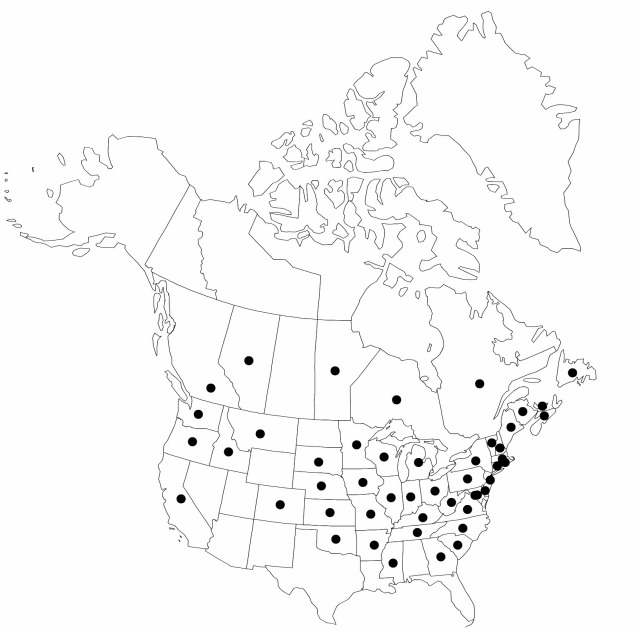Carex scoparia
Sp. Pl. 4(1): 230. 1805.
Plants densely cespitose. Culms 20–100 cm; vegetative culms with few leaves clustered at apex. Leaves: sheath summits U-shaped; distal ligules 2.3–4.8 mm; blades 3–5 per fertile culm, 10–32 cm × 1.4–3 (–3.5) mm. Inflorescences arching or nodding, dense or open, green, yellow, or brown at maturity, 1.5–6 cm × 5–20 mm; proximal internode 2–12 mm; 2d internode 2–13 mm; proximal bracts scalelike, with bristle tip. Spikes 3–10, distinct, ellipsoid, 7–16 × 3–9 (–13) mm, base acute to short-attenuate, apex acute to rounded. Pistillate scales hyaline brown, occasionally with green or gold midstripe, lanceolate, 3.4–4 mm, shorter and narrower than perigynia, apex acuminate. Perigynia ascending or rarely widely spreading, golden brown, conspicuously 5-veined on each face or fewer adaxially, winged to base, lanceolate, flat except over achene, 4.2–6.8 × 1.2–2 mm, length at least 3 times width, 0.35–0.55 mm thick, margin flat, including wing 0.2–0.6 mm wide; beak pale to golden-brown at tip, flattish, ciliate-serrulate, abaxial suture with white or golden brown hyaline margin, distance from beak tip to achene 2.2–4.8 mm. Achenes ovate or elliptic, 1.3–1.7 × 0.7–0.9 mm, 0.3–0.4 mm thick.
Distribution

Alta., B.C., Man., N.B., N.S., Nfld. and Labr. (Nfld.), Ont., P.E.I., Que., Ark., Calif., Colo., Conn., D.C., Del., Ga., Idaho, Ill., Ind., Iowa, Kans., Ky., Maine, Mass., Md., Mich., Minn., Miss., Mo., Mont., N.C., N.H., N.J., N.Y., Nebr., Ohio, Okla., Oreg., Pa., R.I., S.C., S.Dak., Tenn., Va., Vt., W.Va., Wash., Wis., into Europe and New Zealand
Discussion
Varieties 2 (2 in the flora).
Carex scoparia is variable and may, in fact, be a complex of at least 2 species. Given current understanding, 2 varieties are recognized:
Selected References
None.
Key
| 1 | Pistillate scales and perigynium apex golden brown or pale brown, similar in color to perigynium body; perigynia 4.2–6.8 mm, (2.5–)2.8–4 times as long as wide; spikes densely aggregated to distant. | Carex scoparia var. scoparia |
| 1 | Pistillate scales and perigynium apex reddish brown, chestnut, or blackish, contrasting with lighter golden brown perigynium body; perigynia 4.2–5 mm, 2–2.6 times as long as wide; spikes aggregated. | Carex scoparia var. tessellata |
"shortened" is not a number."+timesaslongasinflorescences" is not declared as a valid unit of measurement for this property."not undefined" is not a number."shorter and narrower" is not a number.